Tri-Constituent Compounds : A Usage-Based Account of Complex Nominal Compounding / Elisabeth Huber.
Material type: TextSeries: Topics in English Linguistics [TiEL] ; 114Publisher: Berlin ; Boston : De Gruyter Mouton, [2023]Copyright date: ©2023Description: 1 online resource (XI, 271 p.)Content type:
TextSeries: Topics in English Linguistics [TiEL] ; 114Publisher: Berlin ; Boston : De Gruyter Mouton, [2023]Copyright date: ©2023Description: 1 online resource (XI, 271 p.)Content type: - 9783111080758
- 9783111082110
- 9783111081694
- 425.92 23
- PE1175 .H83 2023
- online - DeGruyter
- Issued also in print.
| Item type | Current library | Call number | URL | Status | Notes | Barcode | |
|---|---|---|---|---|---|---|---|
 eBook
eBook
|
Biblioteca "Angelicum" Pont. Univ. S.Tommaso d'Aquino Nuvola online | online - DeGruyter (Browse shelf(Opens below)) | Online access | Not for loan (Accesso limitato) | Accesso per gli utenti autorizzati / Access for authorized users | (dgr)9783111081694 |
Browsing Biblioteca "Angelicum" Pont. Univ. S.Tommaso d'Aquino shelves, Shelving location: Nuvola online Close shelf browser (Hides shelf browser)
Frontmatter -- Contents -- List of figures and tables -- Abbreviations -- 1 Introduction -- Part I: Theoretical Prerequisites -- 2 Compounds and Compounding -- 3 Multi-word compounding -- Part II: Data acquisition and annotation -- 4 Compilation of a compound database -- 5 Annotation of internal structure -- Part III: Formal and functional description of three-noun compounds -- 6 Formal analysis of three-noun compounds -- 7 Functional analysis of three-noun compounds -- Part IV: The formation of tri-constituent compounds -- 8 Productivity in complex compounding -- Part V: Synopsis -- 9 A portrait of three-noun compounds -- 10 Summary and conclusions -- 11 Outlook -- References -- Subject index
restricted access online access with authorization star
http://purl.org/coar/access_right/c_16ec
This book provides a usage-based perspective to the study of multi-word compounding, analyzing the structural, functional and cognitive aspects of tripartite compounds (e.g. day care center, football game, hotel bedroom). It highlights the heterogeneity of these word-formation products, but also carves out surprising differences to two-word compounds. In order to reveal the step from two-word compounding to multi-word compounding, the book explains why only some compounds are used productively for the formation of more complex compounds. Building on the idea of entrenchment, it provides a theoretical account that allows understanding speakers’ ability to produce multi-word compounds.
Issued also in print.
Mode of access: Internet via World Wide Web.
In English.
Description based on online resource; title from PDF title page (publisher's Web site, viewed 25. Jun 2024)









